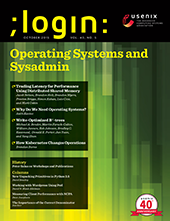
For Good Measure: The Denominator
Website Maintenance Alert
Due to scheduled maintenance, the USENIX website may not be available on Monday, March 17, from 10:00 am–6:00 pm Pacific Daylight Time (UTC -7). We apologize for the inconvenience and thank you for your patience.
If you would like to register for NSDI '25, SREcon25 Americas, or PEPR '25, please complete your registration before or after this time period.
;login: Enters a New Phase of Its Evolution
For over 20 years, ;login: has been a print magazine with a digital version; in the two decades previous, it was USENIX’s newsletter, UNIX News. Since its inception 45 years ago, it has served as a medium through which the USENIX community learns about useful tools, research, and events from one another. Beginning in 2021, ;login: will no longer be the formally published print magazine as we’ve known it most recently, but rather reimagined as a digital publication with increased opportunities for interactivity among authors and readers.
Since USENIX became an open access publisher of papers in 2008, ;login: has remained our only content behind a membership paywall. In keeping with our commitment to open access, all ;login: content will be open to everyone when we make this change. However, only USENIX members at the sustainer level or higher, as well as student members, will have exclusive access to the interactivity options. Rik Farrow, the current editor of the magazine, will continue to provide leadership for the overall content offered in ;login:, which will be released via our website on a regular basis throughout the year.
As we plan to launch this new format, we are forming an editorial committee of volunteers from throughout the USENIX community to curate content, meaning that this will be a formally peer-reviewed publication. This new model will increase opportunities for the community to contribute to ;login: and engage with its content. In addition to written articles, we are open to other ideas of what you might want to experience.

Let’s start with a recent paper that is very much worth your time to read: “Global Cyberspace Is Safer than You Think: Real Trends in Cybercrime” by Eric Jardine and released by Chatham House this past July [1]. Its message is exactly that given by its title: that cyberspace is getting better—not getting worse, that cyberspace is getting more safe—not getting more dangerous. The argument for that message is that thinking cyberspace is ever worse, ever more dangerous comes from failing to properly normalize whatever measures of safety you’ve heretofore been paying attention to. It is only fair to quote its front matter directly:
Information technology (IT) security firms such as Norton Symantec and Kaspersky Labs publish yearly reports that generally show the security of cyberspace to be poor and often getting worse. This paper argues that the level of security in cyberspace is actually far better than the picture described by media accounts and IT security reports. Currently, numbers on the occurrence of cybercrime are almost always depicted in either absolute (1,000 attacks per year) or as year-over-year percentage change terms (50 percent more attacks in 2014 than in 2013). To get an accurate picture of the security of cyberspace, cybercrime statistics need to be expressed as a proportion of the growing size of the Internet (similar to the routine practice of expressing crime as a proportion of a population, i.e., 15 murders per 1,000 people per year).…In particular, the absolute numbers tend to lead to one of three misrepresentations: first, the absolute numbers say things are getting worse, while the normalized numbers show that the situation is improving; second, both numbers show that things are improving, but the normalized numbers show that things are getting better at a faster rate; and third, both numbers say that things are getting worse, but the normalized numbers indicate that the situation is deteriorating more slowly than the absolute numbers. Overall, global cyberspace is actually far safer than commonly thought.
